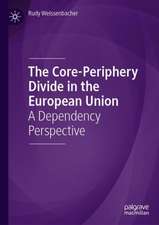A Second Chance for Europe: Economic, Political and Legal Perspectives of the European Union
Editat de Jo Ritzenen Limba Engleză Hardback – 30 mai 2017
Given the sum total of these vulnerabilities, the book argues, the EU may not survive beyond 2025 in its present form – that is, unless decisive action is taken. In turn, the book puts forward a number of workable solutions: a European economic model to secure full employment; a stronger European Court of Human Rights to counter systemic violations; a points-based immigration policy; clear exit options for the Eurozone; and an Open Education Area with a common second language. These solutions may reduce the number of EU countries, but would increase cohesion and overall survivability.
| Toate formatele și edițiile | Preț | Express |
|---|---|---|
| Paperback (1) | 470.24 lei 6-8 săpt. | |
| Springer International Publishing – 2 aug 2018 | 470.24 lei 6-8 săpt. | |
| Hardback (1) | 476.45 lei 6-8 săpt. | |
| Springer International Publishing – 30 mai 2017 | 476.45 lei 6-8 săpt. |
Preț: 476.45 lei
Preț vechi: 560.52 lei
-15% Nou
Puncte Express: 715
Preț estimativ în valută:
91.18€ • 94.84$ • 75.27£
91.18€ • 94.84$ • 75.27£
Carte tipărită la comandă
Livrare economică 14-28 aprilie
Preluare comenzi: 021 569.72.76
Specificații
ISBN-13: 9783319577227
ISBN-10: 3319577220
Pagini: 271
Ilustrații: VII, 271 p. 11 illus. in color.
Dimensiuni: 155 x 235 x 21 mm
Greutate: 0.57 kg
Ediția:1st ed. 2017
Editura: Springer International Publishing
Colecția Springer
Locul publicării:Cham, Switzerland
ISBN-10: 3319577220
Pagini: 271
Ilustrații: VII, 271 p. 11 illus. in color.
Dimensiuni: 155 x 235 x 21 mm
Greutate: 0.57 kg
Ediția:1st ed. 2017
Editura: Springer International Publishing
Colecția Springer
Locul publicării:Cham, Switzerland
Cuprins
European Citizens at Risk.- Halting Support for the EU.- A Vibrant European Model.-In Europe we trust.-EU Mobility.- A sustainable immigration policy for the EU.- A Sustainable Eurozone with Exit Options.- European Identity and the Learning Union.- Forward to a Second Chance for Europe.
Notă biografică
Jo Ritzen is a professorial fellow in the International Economics of Science, Technology and Higher Education at UNU-MERIT and the Maastricht Graduate School of Governance.
He is a former Minister of Education, Culture, and Science of the Netherlands, served in the Dutch Cabinet at the Maastricht Treaty, a former Vice President of the World Bank and former President of Maastricht University.
He is a former Minister of Education, Culture, and Science of the Netherlands, served in the Dutch Cabinet at the Maastricht Treaty, a former Vice President of the World Bank and former President of Maastricht University.
Textul de pe ultima copertă
This book calls upon us to rethink and reboot the European Union. The authors dissect the EU’s many vulnerabilities: how some Member States are backsliding on the rule of law, freedom of the press, and control of corruption – and how globalization’s ‘discontents’ are threatening the liberal international order. It examines the need for a common immigration policy; the need to rethink the unsustainable debt overhang of some Eurozone countries; and the need to use education to foster a European identity.
Given the sum total of these vulnerabilities, the book argues, the EU may not survive beyond 2025 in its present form – that is, unless decisive action is taken. In turn, the book puts forward a number of workable solutions: a European economic model to secure full employment; a stronger European Court of Human Rights to counter systemic violations; a points-based immigration policy; clear exit options for the Eurozone; and an Open Education Area with a common second language.These solutions may reduce the number of EU countries, but would increase cohesion and overall survivability.
Given the sum total of these vulnerabilities, the book argues, the EU may not survive beyond 2025 in its present form – that is, unless decisive action is taken. In turn, the book puts forward a number of workable solutions: a European economic model to secure full employment; a stronger European Court of Human Rights to counter systemic violations; a points-based immigration policy; clear exit options for the Eurozone; and an Open Education Area with a common second language.These solutions may reduce the number of EU countries, but would increase cohesion and overall survivability.
Caracteristici
Dissects the EU’s many vulnerabilities and suggests workable solutions Innovative and creative in pursuing “out of the box” solutions Makes academic analysis directly applicable to major policy questions






















